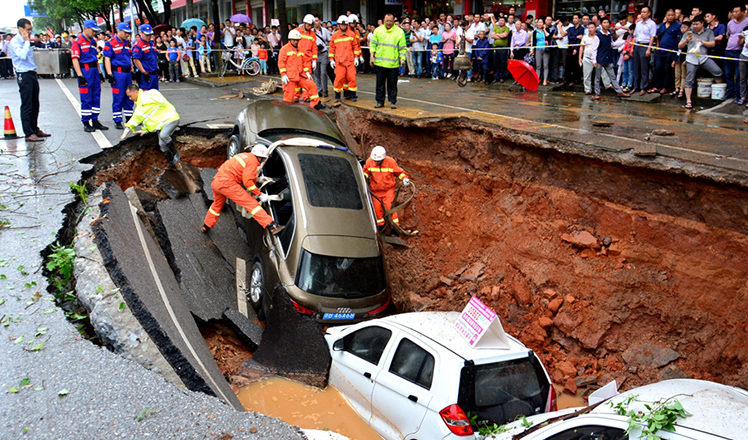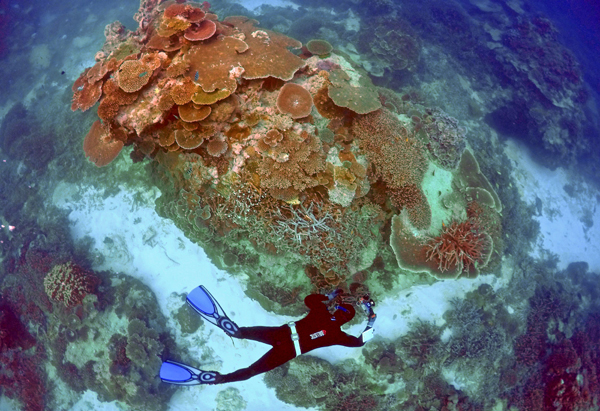35% of northern and central Great Barrier Reef destroyed
Updated: 2016-05-30 09:38
(Agencies)
|
||||||||
SYDNEY - Mass bleaching has destroyed as much as 35 percent of the coral on the northern and central Great Barrier Reef, Australian scientists said on Monday, a major blow to the World Heritage Site that attracts about A$5 billion ($3.59 billion) in tourism each year.
Australian scientists said in March just seven percent of the entire Great Barrier Reef had avoided any damage as a result of bleaching, and they held grave fears particularly for coral on the northern reef.
After further aerial surveys and dives to access the damage across 84 reefs in the region, Australian scientists said the impact of the bleaching is more severe than they had expected.
"This year is the third time in 18 years that the Great Barrier Reef has experienced mass bleaching due to global warming, and the current event is much more extreme than we've measured before," said professor Terry Hughes, director of the ARC Centre of Excellence for Coral Reef Studies at James Cook University.
Bleaching occurs when the water is too warm, forcing coral to expel living algae and causing it to calcify and turn white. Mildly bleached coral can recover if the temperature drops, otherwise it may die.
Although the impact has been exacerbated by one of the strongest El Nino weather systems in nearly 20 years, which recently subsided, scientists believe climate change is the underlying cause.
The survey findings come just days after Australia's Department of Environment confirmed it omitted its contribution to a UN report examining the impact of climate change on world heritage sites over concerns it could create "confusion" and have a negative impact on tourism.
The World Heritage and Tourism in a Changing Climate report, which was released on Friday with no references to Australia, has sparked outrage from climate scientists, who were not informed that their contributions had been removed.
UNESCO's World Heritage Committee last May stopped short of placing the Great Barrier Reef on an "in danger" list, but the ruling raised concern about its future.
Australia is one of the largest carbon emitters per capita because of its reliance on coal-fired power plants for electricity.
Despite pledging to cut carbon emissions, Australia has continued to support fossil fuel projects, including Adani Enterprises Ltd's proposed A$10 billion Carmichael coal project in the Galilee Basin in western Queensland.
- Chinese G20 presidency 'ambitious' in seeking solutions for global growth: OECD official
- UNICEF alarmed at refugee, migrant deaths in Mediterranean
- 35% of northern and central Great Barrier Reef destroyed
- Vintage plane crashed in Hudson River during emergency landing
- 2,000 refugees relocated on first day of major police operation
- No sign of EgyptAir plane technical problems before takeoff

 Graduation ceremony held in Confucius Temple
Graduation ceremony held in Confucius Temple
 Wanda opens theme park to rival Disney
Wanda opens theme park to rival Disney
 Fog turns Qingdao city into a fairyland
Fog turns Qingdao city into a fairyland
 Trams to be in trial use in SW China
Trams to be in trial use in SW China
 children's Day: From cooking meal to catwalk
children's Day: From cooking meal to catwalk
 Beijing style: People embrace the summer heat
Beijing style: People embrace the summer heat
 Ten photos from around China: May 21-27
Ten photos from around China: May 21-27
 VR, robots, mini drones: Highlights of big data expo in Guiyang
VR, robots, mini drones: Highlights of big data expo in Guiyang
Most Viewed
Editor's Picks

|

|

|

|

|

|
Today's Top News
Liang avoids jail in shooting death
China's finance minister addresses ratings downgrade
Duke alumni visit Chinese Embassy
Marriott unlikely to top Anbang offer for Starwood: Observers
Chinese biopharma debuts on Nasdaq
What ends Jeb Bush's White House hopes
Investigation for Nicolas's campaign
Will US-ASEAN meeting be good for region?
US Weekly

|

|








